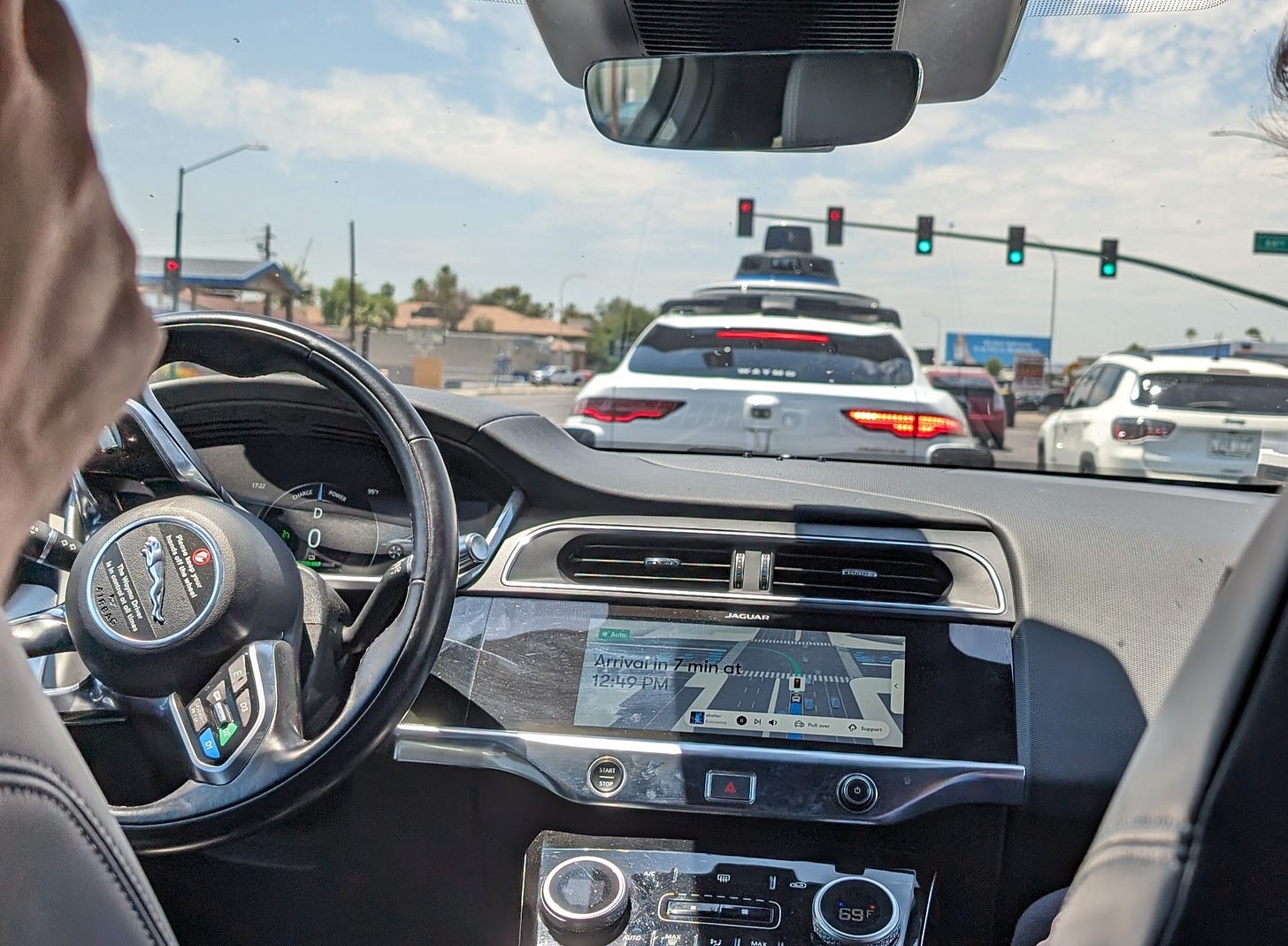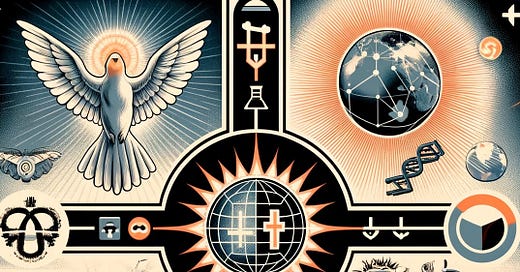I'm starting this summer with a book that provides a comprehensive look at the changing state of religion in the US, a topic I’ve written about before: Strange Rites by Tara Isabella Burton. This book was recommended to me by Ryan Burge when I interviewed him last year. I didn't have time to read it during the semester1, but it lines up remarkably well with the drivers I identified in Futures Research2, giving me added confidence that I explored the space reasonably well.
Current Assessment
The empirical fact that drives the book is simple: as Christianity recedes as not only America’s dominant religion3 but also its civil religion4, giving us our values, metaphors, and so on, a gap is created. Rather than becoming rational creatures devoid of religious activity, Americans5 fundamentally yearn for the “re-enchanting” of a sterile world and are filling this gap with a huge, diverse mix of beliefs, practices, and associations. There are common threads through these practices, though, especially the rejection of institutions and the primacy of objective reality in favor of intuition and finding one’s own path and “truth”, and the goal shifting from a place to belong to a path to seek. This is accomplished by mixing and matching ideas and practices from various sources to cobble together a personal market basket of spiritual fulfillment, something Burton calls Remixing. This isn’t something altogether separate from Christianity, however: about a third of Christians believe in non-Christian ideas like reincarnation and The Secret-style energy/vibration/etc.
So where did this dramatic shift come from? One of the key concepts in the book is that the internet, by making it possible to easily connect with people across geographic boundaries, organized by interests, and with a dramatic decrease in gatekeeping, actively enables and encourages remixing. People no longer need to stay as a member of a local church they don’t fully identify with in order to have a community and a source of meaning. Burton explicitly makes the analogy that the printing press enabled the Protestant Reformation as Luther and others made religion a matter of personal belief based on what you read at home, and the internet moves us from choosers to co-creators of these systems6.
Many aspects of modern society can be seen as partial reconstructions of spiritual practice. The book examines the chaotic world of internet fandom7, wellness culture8, modern witchcraft, and the poly/kink sex scene as providing varying degrees of meaning, purpose, community, and ritual, often using explicitly religious language to do so. Being America, each of these trends/subcultures is actively being exploited by corporate America for profit, with different results: fandoms are in a power struggle with creators for moral ownership of IP, wellness has essentially become a pay-for-absolution racket, witchcraft is struggling because being transgressive is part of its identity, and companies are delicately trying to figure out how to be as inclusive to different groups (and their money) as possible without alienating other consumers9.
Plausible Futures
However, none of these on their own have all the pieces needed to seriously contend as a successor civil religion to Christianity, shaping our moral intuition and language. Each of them, however, informs and gives shape to the three movements that might.
The first is identitarian social justice, seeing the world through the lens of power, oppression, people existing at the intersection of groups giving and receiving that oppression, and the highest good being to struggle against unjust structures. This movement has captured the modern witchcraft movement10, much of the academic discourse, and was briefly ascendant but currently waning in corporate governance.
The second is the Silicon Valley techno-utopianism that looks like a new mix of libertarianism, technocracy, and a conviction that our minds and their creations can help us transcend these fallible meat prisons. Adherents frequently adopt an ascetic approach to wellness11 and a utopian strain of polyamory.
The third movement is the reactionary right-wing movement Burton calls “new atavism12”, convinced that society is corrupted by feminine weakness and decadence, and that the true order of life is rule and domination by the strong13. This exists along a broad spectrum - Jordan Peterson exemplifies an intellectually respectable atavistic version of wellness culture, the supplements Alex Jones sells are like a mirror version of Goop, and the Trump-worshipping, 4chan-dwelling alt-right trolls combine atavism and abject nihilism14, convinced that society is doomed and so it’s funny to blow up as much stuff as possible during the descent.
Burton frames the future as a matter of which of these will become dominant, but I'm not so sure that she's right. Each of these has what seem to be strong demographic home bases - social justice among urban women, techno-utopianism among the wealthy and hip, new atavism among disaffected men. This seems likely to limit each to a separate sphere, and suggests to me that the next few decades will probably be defined by the conflict between each of these and the remaining Christians (also heavily influenced by the intuitional logic that dominates the moment) in conflict and uneasy alliance.
Overall Thoughts
I had hoped this would provide more weak signals of possible distant futures not represented in current trends, but the focus was definitely on “next” and not “next next”. I also feel like there wasn’t enough treatment of conspiracy theories as an important growing quasi-religious belief system (QAnon as a new form of Christianity, for example). But the writing is fun15 and pulls you quickly from example to example. If you care about the future of how we make meaning and what the implications might be for the US, it’s a good read.
Bonus Content: Literal Drivers
A taste of the future I experienced last week: I was in Phoenix for a conference and took my first ride in a self-driving car! Of all people, it was our Uber driver that convinced me to take the plunge16, so I downloaded the app and we took Waymo from our hotel to the airport17. The experience was smooth - the app let us know exactly what to expect, and I would describe the driving as cautious and a little slow but competent. It cost about the same as an Uber18, and there's no driver to tip.

The weirdest thing was that it was literally and precisely a self-driving car - a regular car with pedals, a steering wheel, etc, but with the vehicle itself operating the controls. This is the smallest possible change to the being-driven-somewhere experience short of actually having a dummy in the driver's seat. The underlying service is just transporting humans - one could imagine wildly different seating orientations, form factor (for example, electric vehicles, lacking an engine, don't actually need the nose of the vehicle), ownership model, etc. We could instead use the metaphor of a bus, or a cruise ship, or baby sloths, to design this experience, but instead we make it as normal as possible. I've heard this idea described as “most advanced yet acceptable”, and for AI the underlying technology is so advanced and alien that the form seems to be intentionally conservative so as not to rupture the manufactured normalcy field. We've taken so much standardization for granted in the prior automobile age (gas pumps, lane sizes, hand gestures, honking etiquette, etc), and now we seem due for a few decades of divergent design and adjustment.
Especially when I have to wait for my hold at the library to come in, because I do books in the slowest way possible other than waiting for it to show up at one of Portland’s ubiquitous Little Free Libraries.
Nearly all of them, from the twilight of Christianity to the culture war between the social-justice left and the reactionary right to the co-opting of spirituality by corporations to the a la carte search for meaning to the mainstreaming of fringe practices, take very similar form. My last driver was about changes in the way we use technology toward existing spiritual ends, whereas Burton looks at the way technological progress becomes its own spiritual end.
Ryan Burge posted within the last week that the rapid increase in the group of “nothing in particular” folks has stalled out the last few years. This could be because they’ve consumed their food source of very weakly-attached people, or it could be some kind of pandemic-related data artifact (for example, as watching church from home was normalized, maybe that kept people on the margins identifying as Christians).
Not that this was the case for all of the nation’s history - the absolute dominance of American life and institutions by mainline Protestant groups was a reality of the post-WWII era. During the Revolutionary War era, only 15% of Americans belonged to a church, and many people freely mixed Christianity with various magical practices.
I make this distinction because these trends are much less pronounced in “post-Christian” Europe.
This is a manifestation of the soft technological determinism of Dator’s Third Law, quoting Culkin/McLuhan/etc: “we shape our tools and thereafter our tools shape us”.
I had seen the intensity of the Harry Potter fanbase, but was blown away by Burton’s chapter-long description of it as the origin of so much of our modern fan culture, affecting everything from the signs at protests to the creation of the “Snapewives” community seeking spiritual union with a fictional character (who was, to his credit, the only person in the whole book series who saw Harry for what he was - a pathological rule-breaker with a Messiah complex).
This ranges from the high-end yoni eggs of Goop to the mass-market wellness of WW.
This seems to mostly be a niche brand space; the nearest exceptions are that ill-fated Balenciaga campaign and DoorDash’s 2022 “Eat With Pride” ads.
For example, in earlier decades Wicca and adjacent traditions were focused on gender essentialism and binaries in the form of a dual god/goddess, different roles or groups delineated by biological sex (connecting menstruation to the moon, for example), etc. Now, witchy spaces and genderqueer circles overlap much more, and the movement is understood as opposed not just to patriarchy but to the whole set of constructed categories that normalize our lives.
Erstwhile vampire Bryan Johnson is the patron saint of this.
I had to look it up, because I had only ever heard the term in a Psycho Mantis monologue: atavism is an orientation toward an ancient/primeval age as more morally pure; essentially, nostalgia as philosophy.
The alt-right, of course, doesn’t have a monopoly on atavistic nihilism; the Dark Mountain folks are another expression of the same gnawing certainty that we’re all doomed.
With chapter titles like Twilight of the Chads, how can you go wrong?
He was both depressed about potentially being replaced and convinced that autonomous driving would reduce road deaths.
Phoenix is the only city in America where you can sign up for Waymo and start riding immediately without a waiting list.
Of course, price for these things is less a reflection of the reality of providing a service and more a function of how much money Alphabet is willing to lose per ride in order to collect data and build market share.



